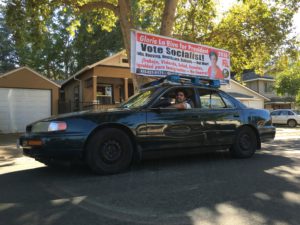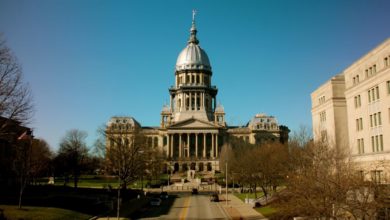 The La Riva for President campaign visited California’s Central Valley last week, speaking to students and workers in Sacramento, Stanislaus and Merced. The PSL is running the only presidential campaign to visit either city. Liberation News has covered the Central Valley before, writing extensively about the drought plaguing one of the United States’ most fertile and agriculturally important regions. The Central Valley is primarily inhabited by first generation Mexican immigrants, Chicano/as, Black Americans and poor whites. The problems facing the Valley are consequently unsurprising: deep poverty, job insecurity, low pay, ecological crisis, police violence, the school-to-prison pipeline, and other issues primarily facing poor, working and oppressed people.
The La Riva for President campaign visited California’s Central Valley last week, speaking to students and workers in Sacramento, Stanislaus and Merced. The PSL is running the only presidential campaign to visit either city. Liberation News has covered the Central Valley before, writing extensively about the drought plaguing one of the United States’ most fertile and agriculturally important regions. The Central Valley is primarily inhabited by first generation Mexican immigrants, Chicano/as, Black Americans and poor whites. The problems facing the Valley are consequently unsurprising: deep poverty, job insecurity, low pay, ecological crisis, police violence, the school-to-prison pipeline, and other issues primarily facing poor, working and oppressed people.
In Stanislaus Liberation spoke with Isaac Muñoz, the Political Chair at MEChA at CSU Stanislaus, about whether politicians care about the Central Valley:
“From a political standpoint, of course [politicians] care about [the Central Valley], but realistically what are they doing to make sure that we’re involved in the vote? Who are your political candidates? Hillary Clinton and Donald Trump. I’m not going to get into who’s the worst candidate or who’s the more viable candidate, but as far as who’s going to best represent the people in the Central Valley, it’s Mexicanos or uneducated minorities, for the most part. Historically—since the 1920’s and 30’s—it’s Chicanos who live in this area. We’re the most underrepresented grouping. We’re the majority, but we’re treated as the biggest minority. Politically we’ve constantly been ignored, every way you look.
“And it goes back to President Obama, too. What was the big thing that he promised everybody? Immigration reform, immigration reform, immigration reform. And not one thing has happened. And that’s why you have big political figures like Jorge Ramos speaking out saying this is wrong. We’ve been consistently ignored. We decided the election both times for him, and we’ve been ignored.
“And now you have a candidate whose entire campaign is focused on what? Deporting immigrants. But who are the immigrants he’s talking about? All you have to do is read between the lines. He’s talking about deporting Mexicanos in particular. Right now what’s going in Central America? People are fleeing there, but how do you get to the United States—the land of opportunity? You have to go through Mexico. Right now, Mexico looks like the [idiot] on this side of the Americas. It’s not Mexico’s fault that all this stuff is going on. It’s not Mexico’s fault that their political system has been garbage since the 1940’s and 50’s. It’s been skewed. The people don’t run things; the narcos run things. The crooked politicians run things. The rich run things. It’s capitalism at its finest. And it’s not just in Mexico. It’s not just in the United States. It’s everywhere… The real issue is inequality itself …
“The United States is constantly involved in things. We’re constantly involved in the domestic affairs of other countries, but our domestic policies don’t’ help anybody out. We incarcerate more than any other country. We rehabilitate fewer than any other country. So what are we doing? We’re locking people up, but we’re not helping anybody out.
“To circle back to your question, I don’t think that politically in the Central Valley anybody’s being helped. If you’re a big farm or big agriculture, what’s your vote going towards? Republican. You’re not allowed to help out the little Chicano kid who wants to get a little education. [Screw] that guy. He works in your field. That’s how I feel about what’s going on in the Central Valley and in Modesto in particular.”
“There are city ordinances in the Central Valley that prohibit murals. What murals do—it’s proven in studies of communities like East Los Angeles and Salinas and San Diego—if you put a mural up in an impoverished community, people take pride in that mural. People don’t want to tag over it. They leave it up there and they take pride in it. But if you have ordinances against it, then all the sudden you have little kids who from a young age walking around. They don’t see anything to take pride in. What they see is gang graffiti: [things like] 187 on so-and-so or on so-and-so. 187 is police code for homicide. These kids are reading about murder on their street walls, on their neighborhood walls where they grow up.
“So in their own neighborhood, there’s war going on. People don’t think about that. People don’t want to understand that this is a problem. And it all starts on the local level. You can talk about federal redistribution of justice, but really it starts on the local level, along with politics. If you want to start initiating change, you have to start in the barrios, in the campos. You can’t just go out there and say, ‘I’m going to run for President, and I’m going to change the world.’ No, you gotta imitate change at the local level first.
“It all starts off with the criminal justice system and the education system being linked. In Modesto, California, where I’m from, what they do is they have a continuation school for troubled youth. If you can’t hack it in the regular school system, you get expelled. When you get expelled, you get sent to continuation school. In continuation school, you’ll be with a bunch of other kids from troubled backgrounds who got kicked out of school as well. So you’re putting all these teens who got kicked out of school into one environment. And the teachers—they’re there for what. They’re supposed to be there to help you out. Really those teachers are there to make sure you’re attending your classes. They’re not really there to make sure you get back to the public school system. They’re not there to help you get a quality education. They’re not there to make sure you’re getting breakfast every day. Are you growing up in a gang neighborhood? Do you need to walk through 5 different gang territories just to get to this campus? No, they’re not worried about that. These troubled teens have enough on their plate to be worried about, but to add on top of that the fact that the public system is against them.
“And when they get kicked out of the continuation schools, they have to see counselors. And these counselors are linked to local law enforcement. And if they don’t go to classes, then it’s an infraction, and they have to pay a fine. And a lot of these kids can’t pay these fines, because they don’t have jobs; they’re not old enough to work. So if they don’t pay these fines, what’s the next thing you do? If you don’t pay a parking ticket, what do the police do? They come pick you up. So now you’re incarcerated—not in prison, but you’re in jail. You’ve got a criminal record for not paying a fine for not attending your counseling sessions.
“Now what happens when you’re in jail? You’re surrounded by other [criminals] and felons. Other people that are causing problems. At that point, it’s a snowball effect that gets bigger and bigger. The problem never gets fixed.
“And then people will wonder, ‘Man, why the hell do we have so many criminals around here?’ You’re not fixing the problems. You’re compounding them, multiplying them when you take these young kids and team them, ‘Well, why go to school when all I’m going to do is get in trouble? All I’m going to do is get locked up.’
“So the education system needs to be more than just mathematics, English composition, history. You need to teach local history. You need to teach philosophy. You need to teach sociology. Teach these kids that the real big bond that kids need to make are social bonds. It begins in your community, but a lot of the bonds that you can make in your community are gang-related social bonds. So when you go to school, you’re surrounded by other gang-related kinds, and it snowballs from there. Same thing with drugs—it just follows that.
“The education system and the criminal justice system are linked. And if you look at it, a lot of people who go to prison have mental issues. Mental issues are supposed to be found in school. That’s why you have teachers who say, ‘I don’t think there’s something completely right with this kid. I’m going to send them to a counselor.’ This counselor could be a psychologist or something. But they don’t do that. So many in prison have some form of a mental problem. So now our prisons are turned into mental institutions.
“But now look at who we’re locking up in California. We’re locking up Black people. We’re locking up Mexicanos. And we’re locking up poor white people. The rich white dude is going to get off. The rich Mexican person is still going to have to go to trial. The rich Black guy—forget it, he’s getting indicted no matter what just because of his skin color.
“It all boils down to finding inequality at the community level, and you have to take it out at the root. You can’t just walk up to a big tree and try to chop it down with an ax. You have to start somewhere. If you don’t want that tree in your backyard, don’t plant it. That’s really what it all comes down to.”





